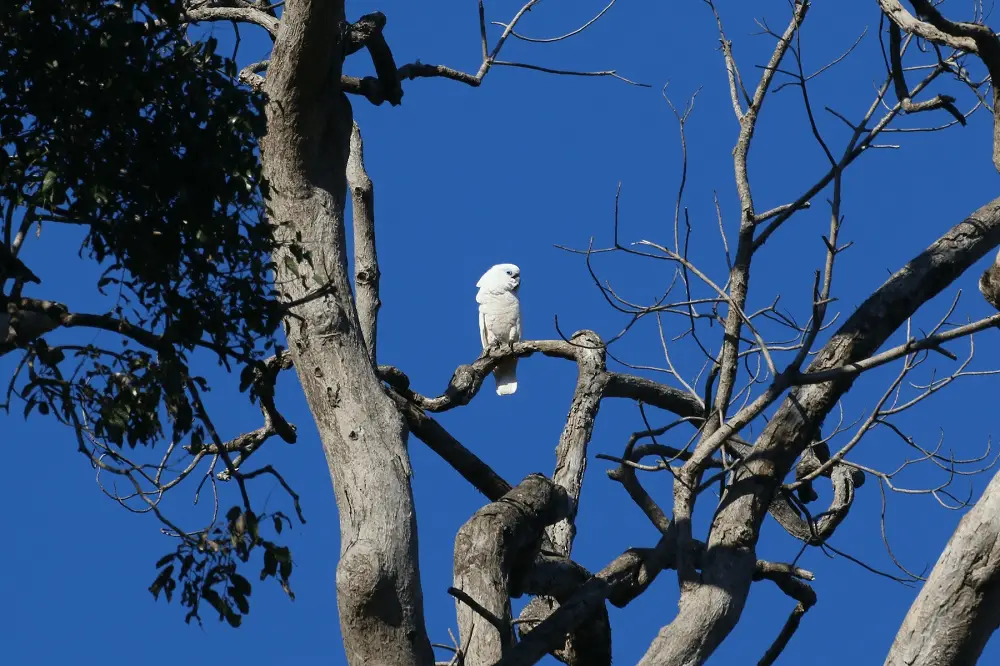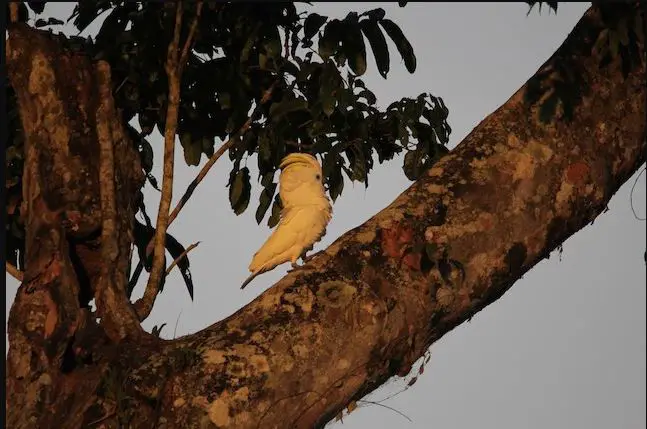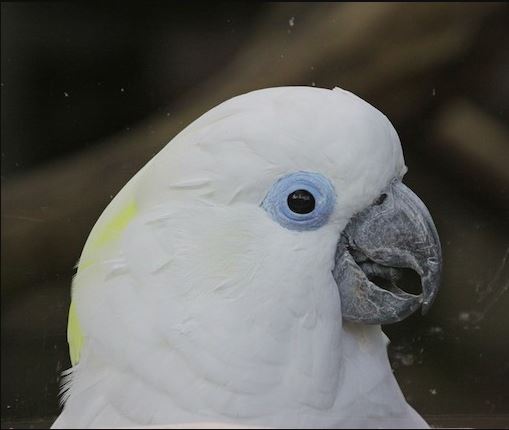
blue eyed cockatoo
Cacatua ophthalmic Scientific name definitions
- VU Vulnerable
- Names (14)
- Monotypic
Identification
Blue eyed Cockatoo 44–50 cm; 500–570 g. White cockatoo with bases of head feathers and undersurfaces of wings and tail suffused yellow; large backward-curving yellow crest

feathers hid, until raised, by similar broad white feathers; bill

grey-black; periophthalmic skin deeper blue than in any other cockatoo; legs and feet grey; male has eye black or dark brown, female reddish. Immature as an adult, but eye grey.
Systematics History
Closely related to C. galerita and C. sulphurea. Monotypic.
Subspecies
Monotypic.
Distribution
New Britain; prehistorically probably also in New Ireland and on Mussau (St Matthias Group).
Habitat
Inhabits lowland tropical forest” data-visible=”false”>inlinemedia, partially cleared areas and small-scale mixed agroforests up to an altitude of 1000 m, but commonest in lowlands and foothills, and rare above 900 m, where known at least from the Whiteman Mts and Mt Talawe. Expected to occur above 1000 m, at least locally. Mainly nests in tall trees in primary forest.
Blue-eyed Cockatoo & Blue-fronted Amazon(Free time )
SOURCE: 鸚鵡用品相關-雜貨舖
Movement
Usually seen flying above the canopy in pairs; may congregate in flocks of 10–20 birds, more exceptionally up to 40 individuals.
Diet and Foraging
blue eyed cockatoo diet:
No information available, but probably feeds on arboreal fruits (particularly figs Ficus), nuts, and seeds. Recent surveys recorded the following in the species’ diet: fruits of coconut Cocos nucifera, Melanolepis multiglandulosa, and an unidentified fig Ficus sp., as well as the flowers of C. Nucifera, Eucalyptus deglupta, and an unidentified Cryptocarya sp.
Sounds and Vocal Behavior
Series of screaming notes, ending with a downward inflection, given while perched, and gull-like notes, each ending in an upslur, while flying; both calls are considered to be higher-pitched, more nasal, and less rasping than those of C. galerita.
Breeding
Until recently, very few data from the wild, other than that nests are in tree hollows. Thirteen nests found during surveys in the late 1990s were 13–50 m (mean 27 m) above ground, with an entrance hole of 18–52 m (mean 35 cm) top to bottom and 14–38 cm (mean 22 cm) wide.
Nests (Jan–May) were found in the following tree species: Bischofia javanica, Dracontomenum Dao, Endiandra sp., Eucalyptus deglupta, Homalium foetidum, Octomeles sumatrana, Planchonella obovoidae, Pometia pinnata, Pometia sp. and P. tomentosa .
In the aviary, two white eggs are incubated, by both sexes, for 28–30 days, with the young remaining in the nest for 12–13 weeks; no information is available on the color of natal down.
Blue-eyed Cockatoo
SOURCE: obirds
Conservation Status
Conservation status on BirdlifeVU Vulnerable
VULNERABLE. CITES II. Very little is known of this species in the wild; population estimated at c.10,000 mature individuals within an overall range of 19,700 km2.
In the late 1990s, densities in the selectively logged forests (64 birds/1 km2) were similar to those in primary areas (up to 73/1 km2) but much less numerous in agroforests (6–28/1 km2.
Rare in captivity overseas and international trade probably low, with high prices (US$4000–27,000 in 1999) commanded for the few birds taken from Papua New Guinea, but commonly kept on plantations around Rabaul. Species are protected by law but, without more information about the current status, no conservation measures can be contemplated.
In the long term, loss of forests to logging (recently calculated at 35% over the last three generations) will limit the extent of suitable breeding habitat, and, as a consequence, recruitment. Extensive research is required on ecology and biology; population surveys and monitoring are also highly desirable.
blue cockatoo price
The price of the blue eyed cockatoo may exceed 10,000$, because it is considered one of the rare mutations




















